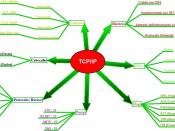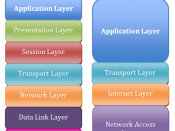The OSI, or Open System Interconnection, model defines a networking framework for implementing protocols in seven layers. Control is passed from one layer to the next, starting at the application layer in one station, and proceeding to the bottom layer, over the channel to the next station and back up the hierarchy. The OSI model is not a real network architecture, because it does not really specify the services and protocols each layer should use. It rather describes what the layers must do. Nevertheless, the ISO has developed its own standards for each layer, and this independently of the OSI model, i.e. as does any manufacturer. Regarding its use and implementation, and in spite of an update of the model in 1994, the OSI model has clearly lost the war against TCP/IP. Only few dominating manufacturers keep the model but it is likely to disappear, all the more quickly since the Internet (and thus TCP/IP) is developing.
The TCP/IP model has become the model of reference in place of the OSI model. Contrary to the OSI model, the TCP/IP model was first implemented before being specified. This particular story makes TCP/IP's characteristics, its advantages and drawbacks. TCP/IP dates from the ARPANET network. ARPANET is a telecommunication network developed by the ARPA (Advanced Research Projects Agency), the research agency of the American ministry of defense (the DOD: Department Of Defense). Besides the possibility to interconnect heterogeneous networks, this network was supposed to resist to a possible nuclear war, contrary to the telephone network usually used for telecommunication but considered as too vulnerable. It was then decided that ARPANET would use a standing out and promising new technology: packet switching (datagram mode). It is to meet this context that the TCP and IP protocols were invented in 1974. The...


